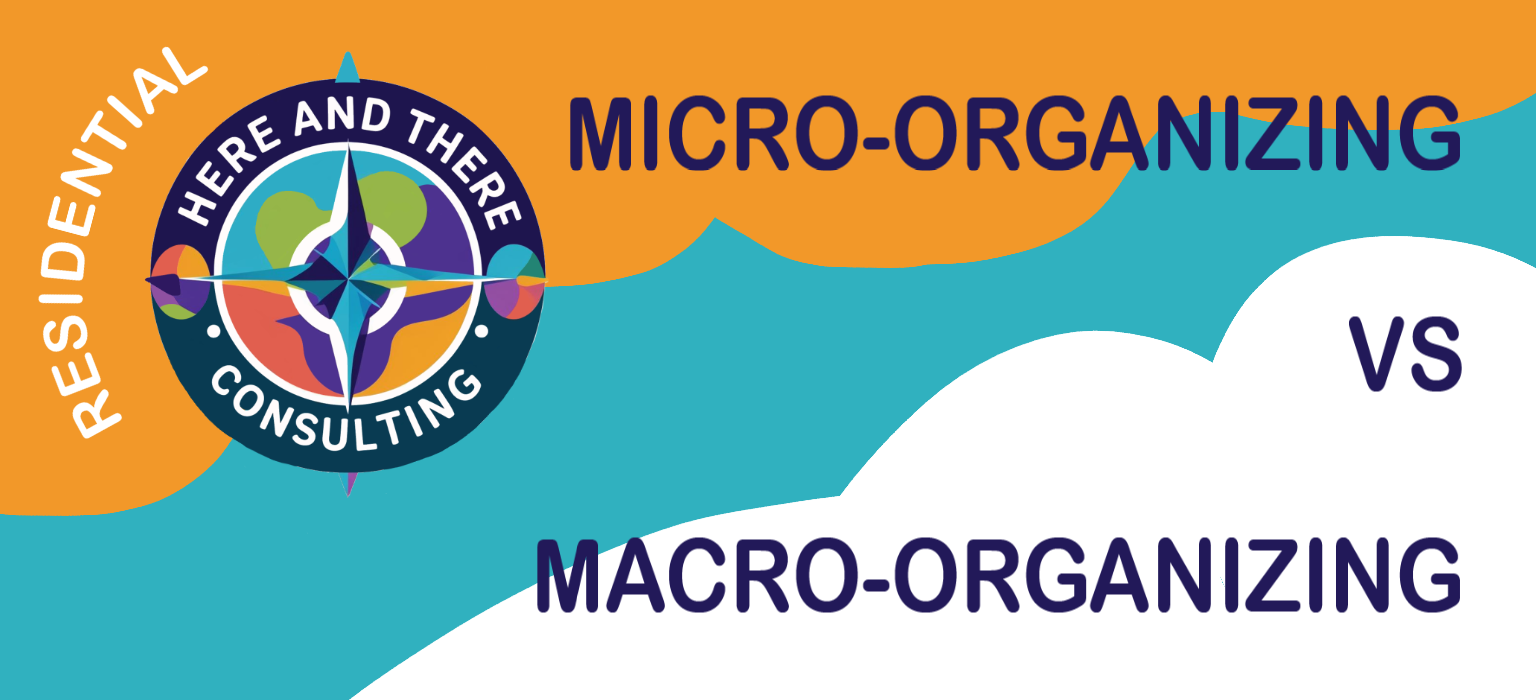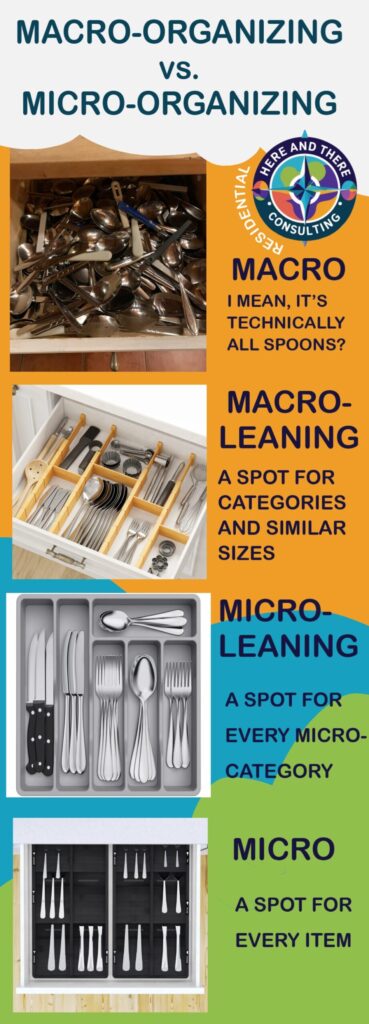
What’s the difference between Micro-Organized and Macro-Organized? It’s the degree of micro-categories.
Micro vs Macro
The organizing industry is ironically not very well organized.
LOL. Just kidding–but it’s definitely not standardized.
Every region, resource, and individual uses different language to describe this process. However, I’m a heckin nerd, so I’ve literally studied about this for fun, and ended up having it come in handy.
Micro and Macro originated in the ancient Greek language. Micro means ‘small or ‘tiny’ and Macro means ‘large’ or ‘long.’ In English, words like microscope embrace the tininess, whereas macroeconomics looks at the economy as a whole.
Clutterbug is the first resource I found who used “Micro-Organizing” and “Macro-Organizing” in the practical sense for professional organizers. I have added Macro-leaning and Micro-leaning language to make my own life easier–especially when I’m working in a team setting, and need to communicate with other professionals assisting me with large projects.
So it’s no surprise that micro-organizing is referring to organizing down to the tiniest detail, and that macro-organizing is just general grouping. They ARE NOT opposites. Both are just different degrees of organizing. I made the graphic below to help make it clearer.

Macro-Organizing and Micro-Organizing In Action
I recently did a project where a gentleman had just finished renovations, and was moving his belongings back into the house from storage. There were dozens of boxes everywhere, and he was extremely stressed that he couldn’t find the things he was looking for.
- Step one was macro-organizing them: every box in the room that made the most sense. Kitchen boxes in the kitchen, clothing near the closets, linens in rooms with beds.
- Step two was macro-organizing just a step further: kitchen items divided into daily use, or special occasion (flatware, dishes, and in his case, the crock-pot versus paper plates, adult drinks, and serving platters that only came out when company was over)
- Step three was organizing another step more detailed: putting things where they are most likely to be used. Flatware in the drawer closest to the table, spatulas next to the stove, shoes and socks together in the closet, etc.
- Step four was micro-organizing within these zones: labeling drawers, organizing with drawer dividers, folding towels, so that they are all visible, easy to find, and efficient in everyday life.
This was an ideal project (for me), because I love the organizing step the most. However, most homes need the decluttering step first. Micro- and macro-organizing still have an important place is this situation.
Micro- and Macro- During Decluttering
I don’t always like to start with clothing (forgive me Marie Kondo, patron Saint of the Konmari Method), because for some people, clothing is sentimental.
However, I was enlisted for a friend’s wardrobe consultation, and this is what worked for her:
- Step One: Envisioning. I had her make a mission-statement for her wardrobe. In her case, her goal was to have less laundry, and spend less time getting dressed in the morning. This is a Macro-goal that we set. She set a goal number (21 outfits) for her wardrobe.
- Step Two: sorting. Also a Macro-organizing step. In this case, she had a small hanging section in her closet, and a large dresser in which things needed to be folded. We sorted clothes by hanging outfits, or folding outfits.
- Step Three: assessing and decluttering. We started with bottoms: pants, leggings, shorts, and skirts. She looked at each item, and put it in a yes, no, or maybe pile. The Yes Pile was her whole bed: and as we found her favorite pants, leggings, and skirts, we put them on the bed. The Maybe Pile was huge–but not as big as the Goodbye Bag.
- This is the important part. Micro-organizing saving my bacon: When we did tops, we sorted them out into separate vibes: we called the first one, ‘bohobbit’ (boho + hobbit) and the second one ‘sporty’, which was a combination of athleisure-wear, ballet-core, and band tees.
- The t-shirts were the most difficult for her, so we broke them down into a micro-category: black t-shirts.
- That wasn’t small enough, so we broke them down, again: black band tees, and plain black tees.
- She kept only two plain black tees.
- She kept quite a few more band tees.
- This made the non-black tees way less formidable for her.
- We went from totally stalled for 7 minutes, to rapidly moving through clothing items again, thanks to micro-organizing the category into a smaller category.
- At this point, we matched the tees to the leggings and shorts on the bed, so that she had pre-made outfits. Then rolled each outfit up together, and micro-organized the outfits into her dresser drawers.
(I didn’t talk much about the hanging section, because it was such a small category.)
We succeeded. She ended up getting rid of everything in the maybe pile, and was left with 32 outfits (not 21) but, still got ride of two 13-gallon trashbags of clothes–probably over 45 outfits.
No wonder she had felt overwhelmed in her routines! Laundry and getting dressed were exhausting when so many clothes (most of which she didn’t like) were in circulation!
Point being: if someone is struggling with a category, micro-organize it, then try again.
Even with Sentimental Items
Even with sentimental items this works really well!
Many people in her family had died, leaving her things that were hard to get rid of.
So we grouped those sentimental items by person.
Her grandmother was the most special, and had left her the most items. She received a lot of cool things. She ended up keeping a number of things that her grandmother had made for her (yarn crafts), a tea-set, and a jewelry box, and passed on other things she loved less to her cousins, mother, and siblings. Including a lovely Japanese doll, that her family-members loved, but that she found a bit creepy. (I saw the doll, I also thought it was creepy.)
Micro-Organizing Can Be Wrong for the Client
I appreciate Clutterbug for bringing this concept to the table. Sometimes the best way to organize is to not organize.
Sometimes the best way to organize is to un-organize.
She did a great youtube video about it.
Here’s a list of those times (my version, not hers):
- Young children can put all their toys in one toybox. Sorting toys into separate bins can be really, really hard or impossible if the child is too young.
- If you wanna get into clutterbug-ideology, a space must be organized for the most visual, most macro-organized person in the space.
- Remove steps out of your routine: hate matching clean socks after laundry day? Get all-matching socks. Hate folding laundry? Designate a place in your closet for your clean laundry-hamper to live. Hate scrubbing dishes? Run the dishwasher twice.
- One big bin is going to be better than lots of tiny drawers for some people.
The reality is that ultra Micro-Organized spaces do not work for everyone. In fact, they don’t work for most people. Taking the micro out of organizing usually helps people be more organized, because the it’s the labor of putting things away that is daunting.
Ultimately, It Depends
Every client is different: as individuals, as families, as work-cultures, as everything! The best thing for your client is what works.
I always hate ‘makeover’ shows that end in the space, or wardrobe, or whatever it is, looking like the person delivering the makeover.
Micro-categorizing for decluttering works more often than not–and macro-organizing for individuals works an astounding amount of the time as well.
Let me know in the comments if any of this worked for you, or was confusing–but I’ve gotta finish this ridiculously long post eventually–so here it is!
Leave a Reply